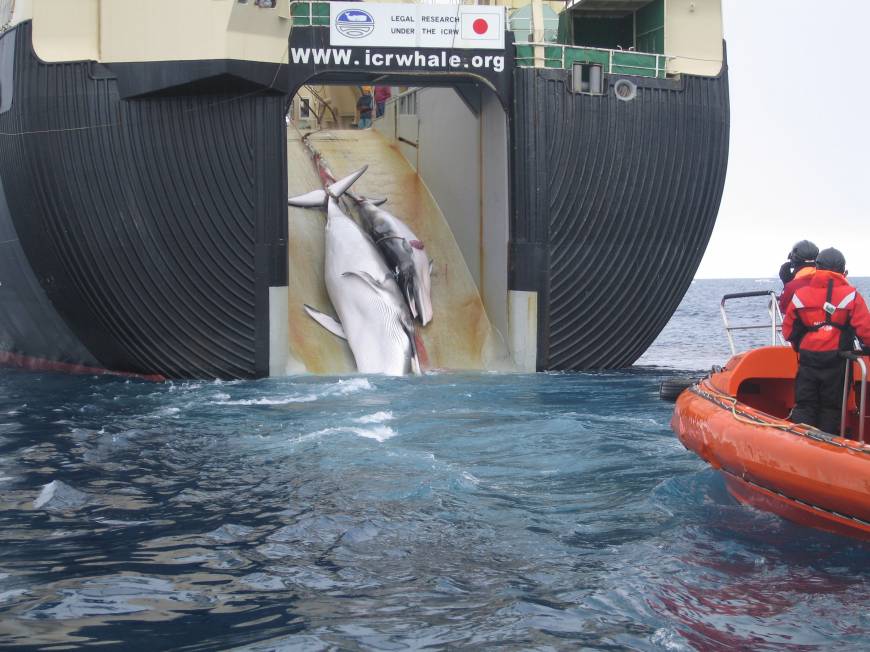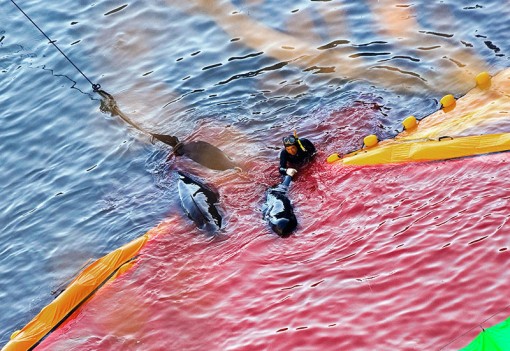Migratory Birds, Fish and Mammals Get New UN Protection
ANIMAL RIGHTS - VEGETARIANISM, 17 Nov 2014
Agence France Presse – TRANSCEND Media Service

End of the line: A Minke whale and her 1-year-old calf are hauled aboard the Nisshin Maru, the world’s only whale-factory ship, in the Southern Ocean in February 2008. In this case, Japan’s ‘legal research’ advertised on the ship’s stern left a large wound from an explosive harpoon in the calf’s belly. | AUSTRALIAN CUSTOMS AND BORDER PROTECTION SERVICE
10 Nov 2014 – Polar bears, whales, sharks and gazelles were among 31 new species granted new protection status by the UN conservation body, following six days of “intense” talks by leading conservationists.
The UN Conservation of Migratory Species of Wild Animals (CMS) said on Sunday [9 Nov 2014] that six days of “intense negotiations” led to new protection for scores of bird, fish and mammal migratory species.
A record 21 species of shark, ray and sawfish were added to the list.
The polar bear, which is found in the Arctic, and the widely-distributed Cuvier’s beaked whale made the list too.
Also newly protected are the red-fronted gazelle, common in Africa, and the great bustard, found in Europe and Asia.
Protecting these animals is key for overall environmental conservation.
“Migratory animals have become the global flagships for many of the pressing issues of our time,” said CMS executive secretary Bradnee Chambers.
“From plastic pollution in our oceans, to the effects of climate change, to poaching and over-exploitation, the threats migratory animals face will eventually affect us all.”
More than 900 experts from 120 countries met for the six-day meeting, approving all but one proposed species to be included on the protected wildlife list.
The African lion did not make the final cut because there was not enough information from the countries where it lives.
The conference was the best-attended in the body’s 35-year history, and CMS hailed the “unprecedented” level of attention to the topic.
The director of the UN Environment Program, which administers CMS, said global interest in animal protection was crucial.
“The responsibility for protecting wildlife is a shared one, and that the threats to wildlife can be tackled most effectively through global cooperation,” said UN Undersecretary-General Achim Steiner, who heads the UNEP.
The next CMS meeting will be held in the Philippines in 2017.
DISCLAIMER: The statements, views and opinions expressed in pieces republished here are solely those of the authors and do not necessarily represent those of TMS. In accordance with title 17 U.S.C. section 107, this material is distributed without profit to those who have expressed a prior interest in receiving the included information for research and educational purposes. TMS has no affiliation whatsoever with the originator of this article nor is TMS endorsed or sponsored by the originator. “GO TO ORIGINAL” links are provided as a convenience to our readers and allow for verification of authenticity. However, as originating pages are often updated by their originating host sites, the versions posted may not match the versions our readers view when clicking the “GO TO ORIGINAL” links. This site contains copyrighted material the use of which has not always been specifically authorized by the copyright owner. We are making such material available in our efforts to advance understanding of environmental, political, human rights, economic, democracy, scientific, and social justice issues, etc. We believe this constitutes a ‘fair use’ of any such copyrighted material as provided for in section 107 of the US Copyright Law. In accordance with Title 17 U.S.C. Section 107, the material on this site is distributed without profit to those who have expressed a prior interest in receiving the included information for research and educational purposes. For more information go to: http://www.law.cornell.edu/uscode/17/107.shtml. If you wish to use copyrighted material from this site for purposes of your own that go beyond ‘fair use’, you must obtain permission from the copyright owner.
Read more
Click here to go to the current weekly digest or pick another article:
ANIMAL RIGHTS - VEGETARIANISM:
